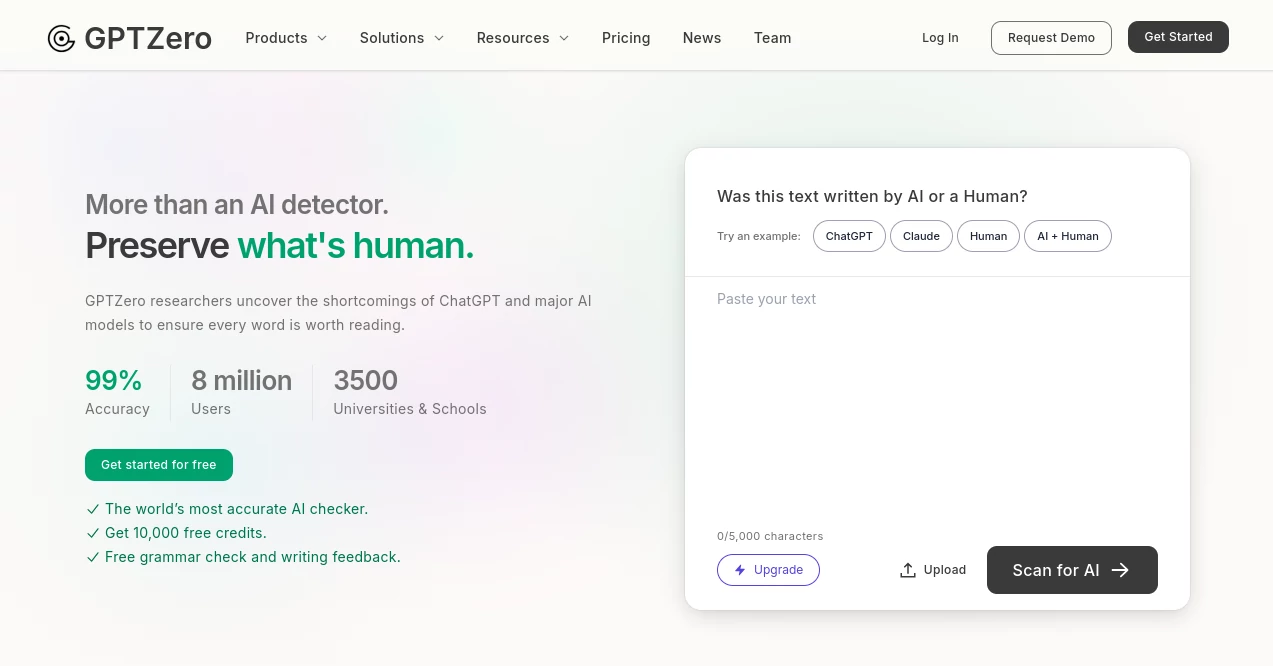🧠 AI Quiz
Think you really understand Artificial Intelligence?
Test yourself and see how well you know the world of AI.
Answer AI-related questions, compete with other users, and prove that
you’re among the best when it comes to AI knowledge.
Reach the top of our leaderboard.

GPTZero
detects AI models in text to bring transparency, distinguishing human written content.

What is GPTZero?
Exploring GPTZero: The Leading AI Detection Tool for Authentic Content Verification
In today’s digital age, artificial intelligence (AI) has revolutionized how we create and consume content. From ChatGPT to GPT-4 and beyond, AI-powered tools have made it easier than ever to generate text that mimics human writing. However, this technological advancement has also raised concerns about authenticity, originality, and the potential misuse of AI-generated content. Enter GPTZero , a cutting-edge platform designed to address these challenges by distinguishing between human-written and AI-generated text. In this article, we’ll dive deep into what GPTZero is, how it works, its key features, and why it’s become an essential tool for educators, writers, businesses, and anyone seeking transparency in the world of AI-driven content.
What is GPTZero?
GPTZero is an AI detection tool developed to identify whether a piece of text was written by a human or generated by an AI model, such as ChatGPT, GPT-3, GPT-4, Gemini, or LLaMA. Launched in January 2023 by Edward Tian, a Princeton University student, GPTZero quickly gained traction as a response to the growing prevalence of AI-generated content in academic, professional, and creative settings. Since its inception, the platform has grown exponentially, serving over 4 million users worldwide and partnering with prestigious institutions like Purdue University and the University of Louisiana system.
The mission of GPTZero is simple yet profound: to bring transparency to a world increasingly filled with AI-produced text. Whether it’s a student submitting an essay, a blogger posting an article, or a company reviewing job applications, GPTZero provides a reliable way to verify the authenticity of written content. Its innovative approach to AI detection has made it a standout solution in an era where distinguishing between human and machine creativity is more important than ever.
How Does GPTZero Work?
At the heart of GPTZero’s functionality are two key metrics: perplexity and burstiness. These concepts allow the tool to analyze text and determine its origin with impressive accuracy.
Perplexity: This measures how random or unpredictable a piece of text is. AI models tend to produce text that is highly structured and predictable because they are trained on vast datasets with consistent patterns. In contrast, human writing often includes quirks, irregularities, and creative deviations that make it less predictable—or more “perplexing”—to an AI model. GPTZero uses this metric to flag text that aligns too closely with AI-generated patterns.
Burstiness: This refers to the variation in sentence length and complexity within a text. Humans naturally write with a mix of short, punchy sentences and longer, more intricate ones, creating a dynamic rhythm. AI-generated text, however, often lacks this variability, producing sentences that are more uniform in length and style. By analyzing burstiness, GPTZero can spot the telltale signs of machine-written content.
Using a combination of these metrics and advanced deep-learning algorithms, GPTZero processes text at multiple levels—sentence, paragraph, and document—to provide a comprehensive analysis. The platform highlights specific sections where AI generation is detected and offers an overall verdict on the text’s authenticity. Unlike other detectors that might simply return a probability score, GPTZero goes a step further by explaining its findings, making it easier for users to interpret the results.
Key Features of GPTZero
GPTZero offers a robust set of features that cater to a wide range of users, from individuals to large organizations. Here’s a closer look at what makes it stand out:
1. AI Detection Across Multiple Models:GPTZero can identify content generated by a variety of AI models, including ChatGPT, GPT-4, Gemini, LLaMA, Claude, and more. This broad compatibility ensures that it remains effective as new AI technologies emerge.
2. Detailed Writing Reports: Beyond a simple “AI or human” verdict, GPTZero provides in-depth reports that include sentence-by-sentence analysis, statistical insights, and even video playback of the writing process (for premium users). This granularity is especially valuable for educators and editors.
3. Batch File Scanning: Users can upload multiple files—such as PDFs, Word documents, or text files—and analyze them simultaneously. This feature is a time-saver for teachers reviewing student submissions or businesses processing large volumes of content.
4. Chrome Extension (Origin): The Origin extension allows users to scan web pages for AI-generated content with a single click, making it ideal for real-time browsing and research.
5. API Integration: For organizations and developers, GPTZero offers an API that can be seamlessly integrated into existing workflows, learning management systems (like Canvas or Moodle), or custom applications.
6. Multilingual Support: While initially focused on English, GPTZero has expanded to include languages like French and Spanish, with plans to support more in the future. This makes it accessible to a global audience.
7. Educational Tools: Designed with educators in mind, GPTZero offers specialized features for academic settings, such as integration with plagiarism checkers and tailored feedback for student writing.
Who Uses GPTZero?
GPTZero’s versatility has made it a go-to tool across various sectors:
Education: Teachers and professors use GPTZero to ensure students submit original work, combating the rise of AI-assisted cheating. The platform’s partnerships with educational bodies like the American Federation of Teachers underscore its credibility in this space.
Content Creation: Writers, bloggers, and publishers rely on GPTZero to verify the authenticity of manuscripts and articles, ensuring their work stands out as human-crafted in a crowded digital landscape.
Hiring and Recruitment: HR departments use it to check the originality of resumes, cover letters, and job applications, filtering out AI-generated submissions.
Legal and Publishing: Legal professionals and publishers leverage GPTZero to authenticate documents and manuscripts, protecting against fraud and copyright issues.
Social Media and Journalism: Moderators and journalists use it to detect AI-generated posts or articles, preserving the integrity of online discourse.
Why GPTZero Matters
The rise of AI-generated content has sparked debates about creativity, ethics, and accountability. While AI tools offer incredible benefits—like speeding up content creation—they also pose risks, such as academic dishonesty, misinformation, and the erosion of human effort. GPTZero addresses these concerns by empowering users to make informed decisions about the content they encounter or produce.
For instance, in education, a small false-positive rate could wrongly accuse a student of cheating, which is why GPTZero strives for accuracy while acknowledging its limitations. The tool’s transparency—explaining how it reaches its conclusions—sets it apart from competitors and builds trust among users. Additionally, its continuous updates and research-driven approach ensure it keeps pace with evolving AI technologies.
Limitations and Criticisms
No tool is perfect, and GPTZero has faced scrutiny for occasional false positives. Human writing can sometimes mimic AI patterns (e.g., highly structured essays), leading to misidentification. Critics, including outlets like The Washington Post and Ars Technica, have noted that even a low error rate can have significant consequences in high-stakes settings like academia. However, GPTZero’s developers actively work to refine its algorithms, and its track record—backed by independent benchmarking—demonstrates best-in-class accuracy.
Getting Started with GPTZero
Using GPTZero is straightforward. Visit https://gptzero.me, paste your text or upload a file, and let the tool do the rest. For larger projects or advanced features, you can sign up for a free account on the dashboard or opt for a premium subscription starting at $9.99/month. The Chrome extension is available for download, and API access is offered for enterprise users.
Conclusion
GPTZero has emerged as a leader in AI detection, offering a powerful solution to one of the digital age’s most pressing challenges: distinguishing human creativity from machine output. With its innovative technology, user-friendly design, and commitment to transparency, it’s no surprise that millions of users—from students to CEOs—rely on it daily. Whether you’re an educator safeguarding academic integrity, a writer protecting your craft, or a business ensuring authenticity, GPTZero is a tool worth exploring. Visit https://gptzero.me today and take the first step toward a more transparent, human-centered digital world.
Large Language Models (LLMs) , AI Tools Directory , AI Writing Assistants , AI Detector , AI Content Detector .
These classifications represent its core capabilities and areas of application. For related tools, explore the linked categories above.
GPTZero details
Pricing
- Freemium
Apps
- Web Tools
Categories
GPTZero Alternatives Product

















